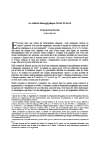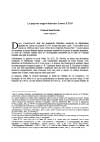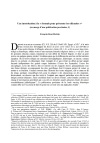Francois Rene Herbin
« La tablette hiĂ©roglyphique MMA 55.144.1 »
ENiM 5, 2012, p. 286-314.
 Étude de la tablette en calcite MMA 55.144.1, portant sur chacune de ses faces neuf lignes d’un texte religieux écrit en caractères hiéroglyphiques. Elle est au nom d’un certain Hor-p(a)-âa fils de Djehouty-her, qui occupait comme son père d’éminentes fonctions dans le clergé de Thot à Hermopolis, probablement à l’époque ptolémaïque. L’un comme l’autre sont inconnus par ailleurs dans la documentation locale. L’originalité de l’inscription, qui intègre quelques extraits du Livre de parcourir l’éternité, réside dans la manière dont est traitée la relation entre le défunt et Osiris, en associant étroitement le titulaire de la tablette aux rites de renaissance du dieu au mois de Khoiak.
Étude de la tablette en calcite MMA 55.144.1, portant sur chacune de ses faces neuf lignes d’un texte religieux écrit en caractères hiéroglyphiques. Elle est au nom d’un certain Hor-p(a)-âa fils de Djehouty-her, qui occupait comme son père d’éminentes fonctions dans le clergé de Thot à Hermopolis, probablement à l’époque ptolémaïque. L’un comme l’autre sont inconnus par ailleurs dans la documentation locale. L’originalité de l’inscription, qui intègre quelques extraits du Livre de parcourir l’éternité, réside dans la manière dont est traitée la relation entre le défunt et Osiris, en associant étroitement le titulaire de la tablette aux rites de renaissance du dieu au mois de Khoiak.
 Study of the calcite tablet MMA 55.144.1, bearing on each side nine lines of a religious text written in hieroglyphs. It belongs to a Hor-p(a)-âa son of Djehouty-her, who both held important duties in the clergy of Thot at Hermopolis, probably in the Ptolemaic period. Both are otherwise unknown in the local documentation. The original feature of the inscription, in which are inserted some excerpts from the Book of traversing Eternity, lies in the way the relationship between the deceased and Osiris is treated, by associating closely the tablet’s owner to the revival rites of the god during the month of Khoiak.
Study of the calcite tablet MMA 55.144.1, bearing on each side nine lines of a religious text written in hieroglyphs. It belongs to a Hor-p(a)-âa son of Djehouty-her, who both held important duties in the clergy of Thot at Hermopolis, probably in the Ptolemaic period. Both are otherwise unknown in the local documentation. The original feature of the inscription, in which are inserted some excerpts from the Book of traversing Eternity, lies in the way the relationship between the deceased and Osiris is treated, by associating closely the tablet’s owner to the revival rites of the god during the month of Khoiak.
 Consulter cet article (48487) -
Consulter cet article (48487) -  Télécharger cet article au format pdf (27650)
Télécharger cet article au format pdf (27650)
« Le papyrus magico-funĂ©raire Louvre E 5353 »
ENiM 6, 2013, p. 257-289.
 Publication du pLouvre E 5353, d’époque romaine et de provenance inconnue, rĂ©digĂ© au profit d’une certaine Ḥr-ʿnḫ. Le papyrus dont le dĂ©but manque est aujourd’hui constituĂ© de quatre pages dont la dernière est restĂ©e vierge de toute inscription ou dessin. On lit sur les deux premières un assez long texte rĂ©digĂ© en hiĂ©ratique, prĂ©cĂ©dĂ© de quelques vignettes empruntĂ©es au Livre des Morts. Introduit par le titre du ch. 125 et quelques sĂ©quences originales dont un emprunt au « grand dĂ©cret Ă©mis pour la province-igeret », ce texte, oĂą interviennent plusieurs officiants, expose un rituel d’exĂ©cration contre Apophis qui se poursuit avec des extraits du ch. 163 du Livre des Morts et de la scène 72 B du rituel de l’ouverture de la bouche. Divers indices rĂ©partis dans l’ensemble du papyrus invitent Ă penser que les opĂ©rations magiques ici dĂ©crites, bien qu’inattendues dans ce contexte funĂ©raire, Ă©taient rĂ©alisĂ©es dans les derniers jours de Khoiak et concouraient comme le reste du texte Ă la renaissance de la dĂ©funte Ă l’instar d’Osiris.
Publication du pLouvre E 5353, d’époque romaine et de provenance inconnue, rĂ©digĂ© au profit d’une certaine Ḥr-ʿnḫ. Le papyrus dont le dĂ©but manque est aujourd’hui constituĂ© de quatre pages dont la dernière est restĂ©e vierge de toute inscription ou dessin. On lit sur les deux premières un assez long texte rĂ©digĂ© en hiĂ©ratique, prĂ©cĂ©dĂ© de quelques vignettes empruntĂ©es au Livre des Morts. Introduit par le titre du ch. 125 et quelques sĂ©quences originales dont un emprunt au « grand dĂ©cret Ă©mis pour la province-igeret », ce texte, oĂą interviennent plusieurs officiants, expose un rituel d’exĂ©cration contre Apophis qui se poursuit avec des extraits du ch. 163 du Livre des Morts et de la scène 72 B du rituel de l’ouverture de la bouche. Divers indices rĂ©partis dans l’ensemble du papyrus invitent Ă penser que les opĂ©rations magiques ici dĂ©crites, bien qu’inattendues dans ce contexte funĂ©raire, Ă©taient rĂ©alisĂ©es dans les derniers jours de Khoiak et concouraient comme le reste du texte Ă la renaissance de la dĂ©funte Ă l’instar d’Osiris.
 Publication of pLouvre E 5353, of Roman Period and of unknown provenance, written for the benefit of a woman named Ḥr-ʿnḫ. The text, whose beginning is missing, nowadays consists of four pages, the last one left free from any inscription or drawing. On the two first pages, one can read a text, rather long and written in hieratic, preceded by a few illustrations from the Book of the Dead. Introduced by the ch. 125 and some original sequences, among which a short borrowing from the “great decree issued for the nome of igeret”, this text, in which several officiants play a part, includes an execration ritual against Apophis, and goes on with excerpts of ch. 163 of the Book of the Dead, and of (the) scene 72b of the Ritual of opening the mouth. Several clues here and there in the papyrus suggest that the magical rites here described, though unexpected in such a funerary context, were performed during the last days of Khoiak, and contributed, together with the rest of the text, to the deceased’s rebirth like Osiris.
Publication of pLouvre E 5353, of Roman Period and of unknown provenance, written for the benefit of a woman named Ḥr-ʿnḫ. The text, whose beginning is missing, nowadays consists of four pages, the last one left free from any inscription or drawing. On the two first pages, one can read a text, rather long and written in hieratic, preceded by a few illustrations from the Book of the Dead. Introduced by the ch. 125 and some original sequences, among which a short borrowing from the “great decree issued for the nome of igeret”, this text, in which several officiants play a part, includes an execration ritual against Apophis, and goes on with excerpts of ch. 163 of the Book of the Dead, and of (the) scene 72b of the Ritual of opening the mouth. Several clues here and there in the papyrus suggest that the magical rites here described, though unexpected in such a funerary context, were performed during the last days of Khoiak, and contributed, together with the rest of the text, to the deceased’s rebirth like Osiris.
 Consulter cet article (49981) -
Consulter cet article (49981) -  Télécharger cet article au format pdf (26970)
Télécharger cet article au format pdf (26970)
« Une introduction Ă la « formule pour prĂ©senter les offrandes » (en marge d’une publication prochaine, 1) »
ENiM 12, 2019, p. 181-200.
 Essai de synthèse sur une formule religieuse dont les premières attestations remontent au tout début du Nouvel Empire, réalisé ici sur la base d’une version démotique conservée sur le P. Bodl. MS. Egypt. a.3(P). Le texte est dépourvu de titre, mais il s’agit, comme l’indiquent plusieurs parallèles, d’un des derniers témoins connus d’une « formule pour déposer les offrandes » (rA n wAH xwt). Son analyse linéaire, mais aussi l’examen des différents contextes où elle apparaît au cours de son histoire, permet d’en situer la lecture dans le calendrier religieux. La présence de cette formule dans le manuscrit d’Oxford à côté d’une version originale du Rituel de faire sortir Sokar de la STyt dont la lecture tombe le 25 Khoiak (date explicitement mentionnée en II, 1), ainsi que nombre d’éléments internes, confirment si besoin était son appartenance au corpus des rites osiriens de ce mois.
Essai de synthèse sur une formule religieuse dont les premières attestations remontent au tout début du Nouvel Empire, réalisé ici sur la base d’une version démotique conservée sur le P. Bodl. MS. Egypt. a.3(P). Le texte est dépourvu de titre, mais il s’agit, comme l’indiquent plusieurs parallèles, d’un des derniers témoins connus d’une « formule pour déposer les offrandes » (rA n wAH xwt). Son analyse linéaire, mais aussi l’examen des différents contextes où elle apparaît au cours de son histoire, permet d’en situer la lecture dans le calendrier religieux. La présence de cette formule dans le manuscrit d’Oxford à côté d’une version originale du Rituel de faire sortir Sokar de la STyt dont la lecture tombe le 25 Khoiak (date explicitement mentionnée en II, 1), ainsi que nombre d’éléments internes, confirment si besoin était son appartenance au corpus des rites osiriens de ce mois.
 A summary report about a religious formula whose first attestations date back to the very beginning of the New Kingdom. The starting point for this study is a demotic version written on P. Bodl. MS. Egypt. a.3(P). The text is preceded by no title but it is, as shown by several parallels, one of the last known attestations of a “formula for presenting offerings” (rA n wAH xwt). Its linear analysis, but also examination of the different contexts in which it appears throughout its history, make it possible to situate the reading in the religious calendar. The presence of this formula in the Oxford manuscript next to an original version of the Ritual of bringing Sokar out of the STyt, read on 25 Khoiak (this date is explicitely specified in II, 1), as well as many internal elements, confirm if need be its place in the corpus of the rites performed that month.
A summary report about a religious formula whose first attestations date back to the very beginning of the New Kingdom. The starting point for this study is a demotic version written on P. Bodl. MS. Egypt. a.3(P). The text is preceded by no title but it is, as shown by several parallels, one of the last known attestations of a “formula for presenting offerings” (rA n wAH xwt). Its linear analysis, but also examination of the different contexts in which it appears throughout its history, make it possible to situate the reading in the religious calendar. The presence of this formula in the Oxford manuscript next to an original version of the Ritual of bringing Sokar out of the STyt, read on 25 Khoiak (this date is explicitely specified in II, 1), as well as many internal elements, confirm if need be its place in the corpus of the rites performed that month.
 Consulter cet article (45515) -
Consulter cet article (45515) -  Télécharger cet article au format pdf (22835)
Télécharger cet article au format pdf (22835)
ENiM 18 - 2025
8 article(s) - 8 octobre 2025.
ENiM 1 à 18 (2008-2025) : 227 articles
5 281 665 téléchargements
10 537 708 consulations.
Index des auteurs

Mots clés

Derniers articles : 
CENiM - Mise en ligne des volumes Ă©puisĂ©s : 
 Anne-Sophie von BOMHARD DĂ©cans Ă©gyptiens, CENiM 23, Montpellier, 2020 — (2020)
Anne-Sophie von BOMHARD DĂ©cans Ă©gyptiens, CENiM 23, Montpellier, 2020 — (2020) 
 Jean-Claude Grenier L'Osiris ANTINOOS, CENiM 1, Montpellier, 2008 — (26 dĂ©cembre 2008)
Jean-Claude Grenier L'Osiris ANTINOOS, CENiM 1, Montpellier, 2008 — (26 dĂ©cembre 2008) 
TDENiM - Mise en ligne des volumes Ă©puisĂ©s : 
 Twitter
Twitter 4197839 visites - 5211 visite(s) aujourd’hui - 145 connecté(s)
© ENiM - Une revue d’égyptologie sur internet
Équipe Égypte Nilotique et Méditerranéenne - UMR 5140 - « Archéologie des Sociétés Méditerranéennes » (Cnrs) - Université Paul Valéry - Montpellier III
























 Contact
Contact
 Abonnez-vous !
Abonnez-vous ! Équipe Égypte Nilotique et Méditerranéenne
Équipe Égypte Nilotique et Méditerranéenne UMR 5140 « Archéologie des Sociétés Méditerranéennes » (Cnrs)
UMR 5140 « Archéologie des Sociétés Méditerranéennes » (Cnrs) Université Paul Valéry - Montpellier III
Université Paul Valéry - Montpellier III